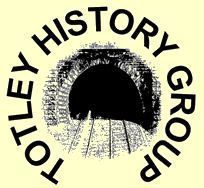The Rise of Totley Rise: From Industrial Hamlet to Urban Community by Pauline Burnett published by Totley History Group, price £5. See below for availability.
My own acquaintance with Totley Rise goes back to 1967, when my family moved to Bradway and I went to the then Totley County primary school. Like almost all kids at that time I walked to and from school, which brought my friends and I within range of Bonner's newsagent, Gratton's grocers and most particularly Edith Spring's sweetshop.
As this book shows, the history of 'Bricky Row' is much longer than that. The first thing which took me by surprise was its exposure of the fallacy that the Rise was built with bricks left over after completion of Totley Tunnel, or to house the navvies working on that project. In fact, most of the terrace was built between 1879 and 1882, whereas the Act of Parliament allowing the Dore to Chinley railway line was not passed until 1884, work didn't start until 1888 and the Tunnel finally opened in 1893.
The historic heart of Totley is at the top of the hill where Totley Hall Lane and Hillfoot Road meet the main road; 150 years ago little existed between there and the mill at the bottom of Baslow Road which by the late 19th. century was owned by William Tyzack, a name famous in the Sheffield steel industry. It seems likely that the original terrace was built for Tyzack's or one of the four other mills in the local area, or maybe the latter stages were done by Ebenezer Hall (of Abbeydale Hall fame) who acquired the land at auction in 1881, subsequently selling portions of it for railway development.
Chronologically and in fascinating detail, Pauline Burnett's book tells the story of this small piece of land through Victorian and Edwardian times, two World Wars and up to the present day. The coming of the turnpike road and then the railway swelled the population who needed shops, and more shops as houses sprang up around. Dore of course gets a fair mention as our two villages are so historically entwined - not just by the shared railway station but also schools and churches, both of which existed first in Dore and were shared until Totley built their own facilities.
The history of the top three shops on Totley Rise and their relationship with the alcohol business are a story on their own, but there are so many other stories here that it's difficult to pick a favourite.
Where this book really comes alive though, is in the final section where those of us who have lived here for a few years will remember where they came in to the story. Colin Thompson established his butcher's shop in the early years of the 20th century and also had a shop in Dore. Ernest Chambers the fishmonger arrived in the 1930s, as did Edith Spring who bought the sweetshop from her cousin in 1932. She ran the shop until shortly before her death in 1980, at the age of 94. Like me, many people will remember John Bonner running the newsagent, those old enough may recall Robert Topham who had it before him and others will know Peter Swift who came after, and who in 1977 discovered a wheelbarrow- full of coins hidden behind a wall in the shop!
The longest serving name on the Rise today is that of Scriven, where Martin runs the greengrocer at number 37. His parents John and Iris Scriven opened the shop as ‘Fruiterama’ in 1967 and Martin took over in 1994.
I found the book to be an absolute delight, and a comprehensive index makes it easy to look up individual places and people which will help to settle the inevitable arguments that long, but failing memories produce.
The book is currently available at Dore and Totley Rise Post Offices, Scriven’s Greengrocer and from Totley Library, priced at a very reasonable £5. www.totleyhistorygroup.org.uk
John Eastwood
Dore to Door No. 118 Summer 2015

